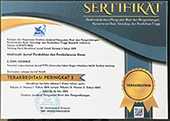Analisis Butir Soal IPA Try Out USBN Tahun Ajaran 2018/2019 dalam Kaitannya dengan Level Kognitif
Abstract
Keywords
Full Text:
PDFReferences
Azwar, Saifuddin. (2013). Tes Prestasi (fungsi dan pengembangan pengukuran prestasi belajar) edisi II, Yogyakarta: Pustaka Pelajar Offset.
Dahar, R.W. (1989). Teori-Teori Belajar. Jakarta: Depdikbud Dirjen Dikti.
Dewi Juliah Ratnaningsih. (2013). Analisis Butir Tes Objektif UAS Mahasiswa UT Berdasarkan Teori Tes Modern. Jurnal Pendidikan Terbuka dan Jarak Jauh, Volume 14, Nomor 2, 98-109.
Ginsburg, H.P., & Opper, S. 2016. Piaget’s Theory of Intellectual Development Third Edition. USA: International Psychotherapy Institute.
Huda, Nuril. (2015). Analisis karakteristik perangkat sola ujian akhir semester gasal matematika wajib kelas X di SMA Negeri 9 Yogyakarta. Prosiding Seminar Nasional Matematika dan Pendidikan Matematika di Universitas Muhammadiyah Purworejo. Purworejo: UMP.
Mantondang, Zulkifli. (2009). Validitas dan reliabilitas suatu instrument penelitian. Jurnal Tabularasa PPS UNIMED Vol.6 No. 1. Medan: Unimed.
Mardapi, Djemari. (2008). Teknik Penyusunan Instrumen Tes dan Nontes. Yogyakarta: Mitra Cendikian Press.
Mardapi, Djemari. (2012). Pengukuran Penilaian dan Evaluasi Pendidikan. Yogyakarta: Nuha Medika.
Mistiani, Wiwin. (2016). Analisis butir soal dengan pendekatan classical test theory dan item response theory. Paedagogia: jurnal pendidikan Vol. 5 No. 1: 122-145.
Mukhlisah AM. (2015). Pengembangan kognitif jean Piaget dan peningkatan belajar anak diskalkulia. Jurnal Kependidikan Islam Volume 6 nomor 2. Surabaya: UIN Sunan Ampel.
Peraturan Pemerintah Nomor 19 Tahun 2005 tentang Standar Nasional Pendidikan. Diakses pada tanggal 6 September 2019, hlm 19 https://kemenag.go.id/file/dokumen/PP1905.pdf
Pusat Penilaian Pendidikan Badan Penelitain dan Pengembangan. (2017). Panduan Penulisan Soal 2017 SD/MI. Jakarta: Kemendikbud.
Sanaky. (1998). Teknik Menyusun Alat Evaluasi Belajar Mata Pelajaran Al-Islam dan Bahasa Arab. Makalah disajikan pada acara pembinaan guru Madrasah Mu’allimat Muhammadiyah tanggal 26 September 1998 di Yogyakarta.
Setyawarno, Didik. (2017). Penggunaan Aplikasi Software Iteman (Item and Test Analysis) Untuk Analisis Butir Soal Pilihan Ganda Berdasarkan Teori Tes Klasik. JIFP (Jurnal Ilmu Fisika dan Pembelajarannya) volume 1, no. 1, Palembang: UIN Raden Fatah March 17.
Setyawarno, Didik. (2017). “Modul kuliah penilaian dan evaluasi pembelajaran IPA”. Disampaikan pada perkuliahan prodi pendidikan IPA Fakultas MIPA UNY. Yogyakarta: UNY.
Sudaryono. (2011). Implementasi Teori Responsi Butir (Item Response Theory) Pada Penilaian Hasil Belajar Akhir di Sekolah. Jurnal Pendidikan dan Kebudayaan, Vol. 17, Nomor 6, 719-732.
Sukardi. (2003). Metodologi Penelitian Pendidikan: Kompetensi dan Praktinya. Jakarta: Bumi Aksara.
Wahyuni, Tutik Sri. (2010). Kajian Pemahaman Konsep Materi dan Perubahannya pada Siswa Kelas IX SMP Negeri 1 Tulungagung. Skripsi Tidak Diterbitkan. Malang: Jurusan Pendidikan Kimia FMIPA Universitas Negeri Malang.
DOI: https://doi.org/10.18860/mad.v12i1.7686
Copyright (c) 2019 Madrasah: Jurnal Pendidikan dan Pembelajaran Dasar

This work is licensed under a Creative Commons Attribution-NonCommercial-ShareAlike 4.0 International License.






